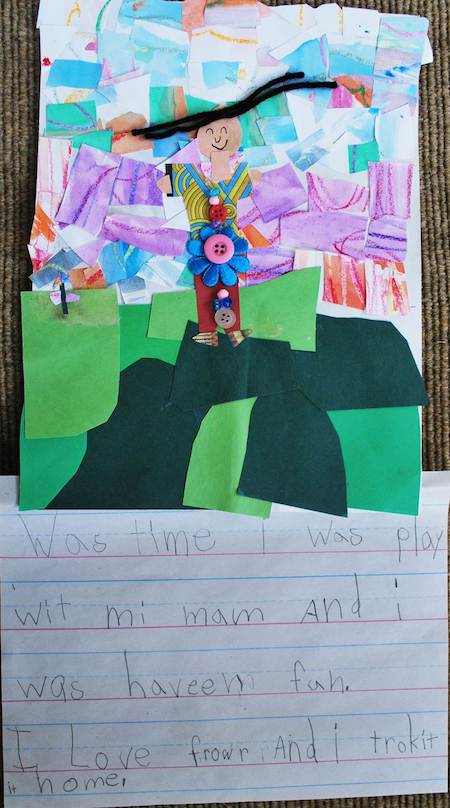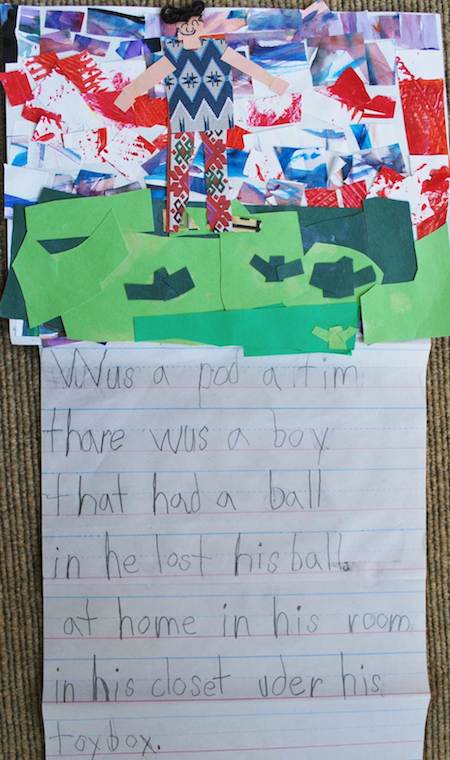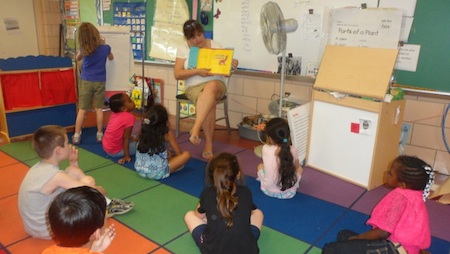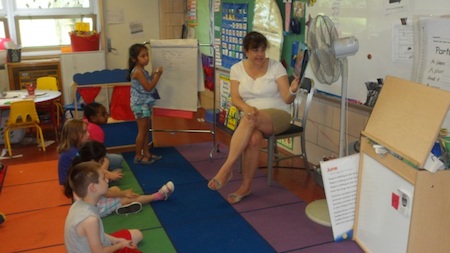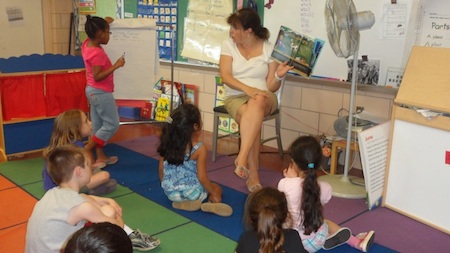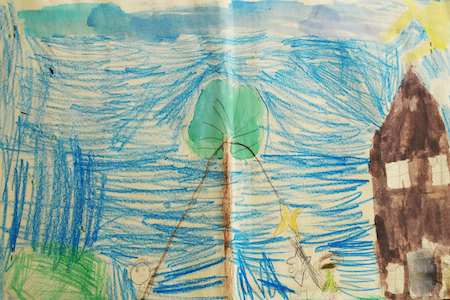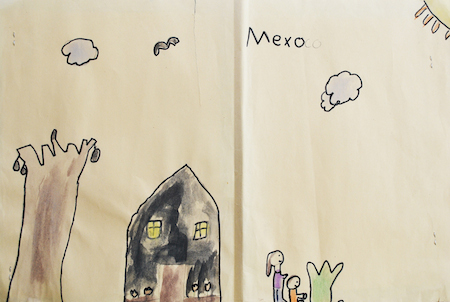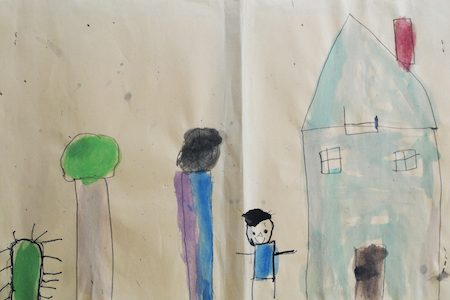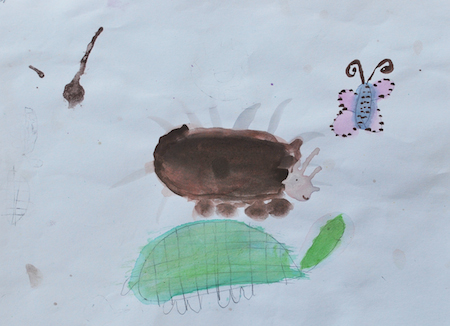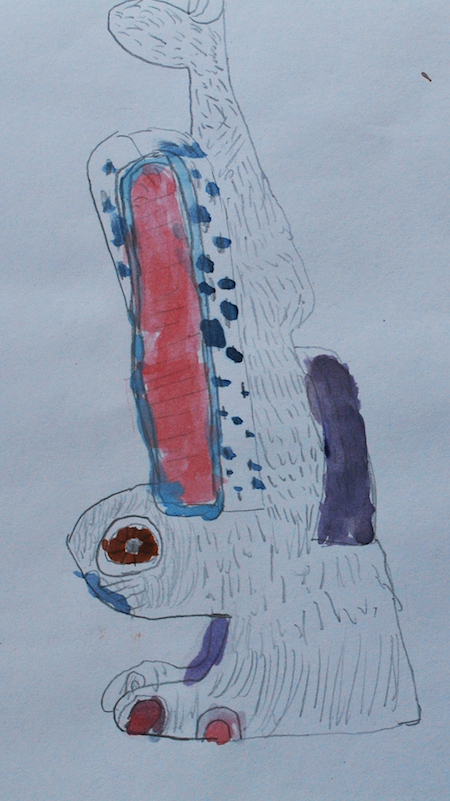Developing Art, Language, and Writing through Discussions of Friendship and Culture in Kindergarten
by Robbie Stout & Elizabeth Soper
We started the year helping our kindergarten students know themselves as cultural beings through stories and discussions about culture. As Kathy Short (2009) states, “All learners, adults and children, must explore their own cultures before they can understand why culture matters in the lives of others around them” (p. 3). As teachers we understood the need not to push too hard at the beginning of the year so that students could develop skills and confidence, which proved to be a positive road for us to take. The children made tremendous progress and we delighted in their involvement in the ever changing projects over the year. During the first half of the year we focused on the art of authors such as Mo Willems so the children could learn how artists represent emotions, movement, and feelings through color, line, and shape to convey meaning. The children had opportunities to use this learning in their own work.
After exploring our identities, we spent the second part of the year reading and writing stories about friendship. We discussed the character traits of friends and how to be a good friend to others. We also did a cross-cultural study of Mexico to help the children “consider points of view beyond their own” so they came to understand that “their perspective is one of many ways to view the world” (Short, 2009, p. 4). Throughout the year we worked as a team to share ideas but we each explored those ideas independently in our own classrooms, since each class had different strengths and challenges. The following vignette shares what we did in our classrooms to explore friendship through art and literature. First, Liz discusses her class’s experiences around our focus on friendship. Stacy Aghalarov, the art teacher, shares how she integrated friendship into her art instruction. Finally, Robbie discusses her class’s study of Mexico.
Elizabeth Soper: Friendship is Everywhere and in Everyone
In kindergarten we focus on friendship as a theme to build our team of learners. We explore how each of us has a unique identity, but we can be friends with everyone. The children in my class had diverse cultural backgrounds (i.e., Iran, Iraq, Mexico, India, Mali, etc.) which added to the richness of our discussions around friendship being everywhere and in everyone.
We read many books on friendship from within our immediate world and that reached beyond our own parameters to worlds that are unfamiliar. For example, we read the art in A Circle of Friends (Carmi, 2003) about a boy who shares his muffin with a homeless man which starts a circle of caring and helping others. We also read The Sandwich Swap (Queen Rania & DiPucchio, 2010) about two girls who learn they can be friends even though they like different things. Through our discussions and personal connections, students deepened their understandings of friendship, learned different ways they can be a friend to others, and expanded their language about friendships. We have found that confidence in language plays an important role in opening up opportunities for children to become inspired and motivated.
We believe that art is a way for students to communicate more easily, regardless of oral language strengths. We worked closely with Stacy Aghalarov, the art teacher, to connect what we were discussing in our classrooms with what the students were doing in art. As part of our focus on friendship, we collaborated with Stacy around Listen to the Wind: The Story of Dr. Greg & “Three Cups of Tea” (Mortenson & Roth, 2009). Below, Stacy shares what she did with this book during art instruction with our students:
In my kindergarten art classes, I started by reading the book Listen to the Wind: The Story of Dr. Greg and ‘Three Cups of Tea’ (Mortenson & Roth, 2009). After we read the story together, I asked the students how Dr. Greg was a friend to the people of Korphe, a Himalayan village. “Dr. Greg helped them build a school for the children,” Cory answered. Brian added, “He helped some of the people feel better when they were sick.” Susie said, “He built a bridge to their village so they could bring the wood for the school.” After we thought more of friendship, I had students use the remainder of our class time to draw a picture of how they show friendship to another person, a family member, or an animal.
The next week, we first focused closely on Susan Roth’s art in the book and how she created the pictures. The students decided that the pictures were not created just with paint, but that Susan Roth added other materials like cloth or paper. I explained to the students that when an artist uses other materials like cloth, paper, paint, etc., in one picture, it is called a collage.
I showed the students a bin of paper that my fifth grade classes had created and not used in a project. Each piece of paper was filled with different colors of paint. The students chose three different pieces of paper that had similar colors and started cutting quarter sized shapes. They glued these shapes on paper to create the sky for their backgrounds. After the sky was complete, they used green construction paper to cut out hills.
In our final class for this project the students created a self-portrait in Roth’s style from the book. I showed them how to cut out shapes from patterned paper to create their body and then add arms, legs, and a head. After they drew their faces, I pulled out a bin of buttons, ribbon, yarn, beads, and little pieces of cloth and invited the students to use these materials to create cloths, bows, accessories, and hair. They worked for the rest of the class period to complete their self-portraits.
Back in our classroom, I interviewed the children about the decisions that went into their choices in creating their art work. Jacob, Nevaeh, and Julian are examples of what went into their personal decision making on creating the art.
Nevaeh also discussed her reasons for creating the art that she created.
Julian discussed his process as well. Julian was shy and exhibited confidence issues, so his conversation was rewarding because he seemed enthused.
The children worked on the stories to accompany their art for a few days. They engaged in sustained independent writing and we provided opportunities for children to manage their time and story line from beginning to end. They loved writing and Writer’s Workshop, as evidenced by their stories.
Jane’s art is in Figure 4. She wrote, “Once upon a time the girl got missing. There was too many clouds so she couldn’t get home and then she found her way home.”
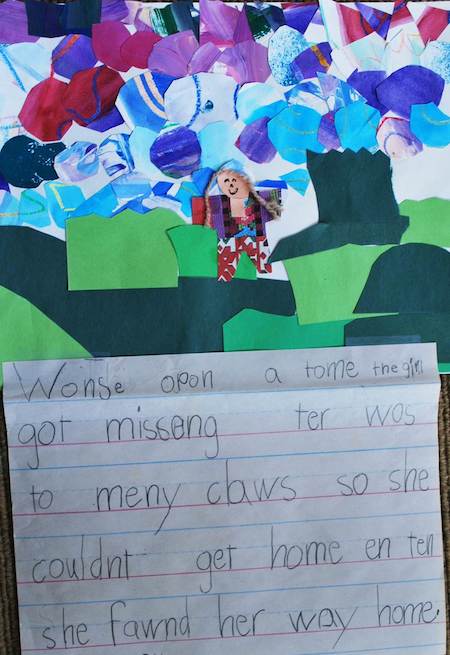 Figure 4 |
In her story, Lori wrote, “One time I was playing with my mom and I was having fun. I love flowers and I took it home” (see Figure 5).
Nevaeh’s art and story are in Figure 6. She wrote, “The Nice Girl. Once upon a time there was a girl that loved flowers and she picked up a flower and she wanted to show it to her family and they put it in their back yard. They love it so much.”
For his art, Emmanuel wrote, “Once upon a time there was a boy that had a ball and he lost his ball at home in his room in his closet under his toy box” (see Figure 7).
To pull together our focus on friendship, we made a video. I had the children work in pairs and used question prompts to record what “Friendship in Everyone” means to them personally in their everyday lives. I gave them time to share ideas with each other first, then interviewed them as partners. Emanuel and Alex examined some attributes of friendship in this video.
Arshin and Ella carry on what they feel is important in a friendship:
Through our reading, writing, and discussions of friendship the children grew in their understandings of who friends are and what it means to be a friend. They demonstrated a stronger sense of self-confidence and were motivated to be better friends to each other which in turn decreased problems in their interactions with each other. I look forward to exploring friendship again with my class next year.
Robbie Stout: Our Study of Mexico
We started the year by talking with our students about identity and connecting to the places in the world where our families originated on a world map. We read global picturebooks about self and families and invited the children to share stories of their lives and experiences, followed by our focus on friendship as described by Liz.
After friendship, we decided to move to a cross-cultural study on Mexico. In my class of 18 students, four Spanish-speaking students received services from our ELL teacher and two additional students spoke Spanish. To capitalize on this connection to Mexican culture, Liz and I decided to look for global literature that would help us explore this culture in more depth. I found several books about Mexico that were age appropriate and that had interesting art as well as text. Since it was early May, we started with Cinco de Mayo. By this point in the year, students’ writing was more developed and I wasn’t taking as much dictation to get down their ideas. I wanted to see if reading books about Mexico would create an interest in writing.
Before beginning our study, I had students share what they knew about Mexico and we wrote their thoughts on a classroom anchor chart. Their thoughts included “Mexico is a place”, “They speak Spanish there,” and “Butterflies live there.” Then I had students write about Mexico. I was looking to see if students would write about their own ideas from the anchor chart and if they would incorporate others’ ideas in their writing.
During Writer’s Workshop, we read books about Mexican culture, such as What Are You Doing? (Armandi, 2011) about a family and their love of reading. We read Gracias/Thanks (Mora, 2009) about a Latino family and their use of Spanish and English words. We also read In My Family (Garza, 2000) about a Latino family and their traditions.
As we read these books, we wrote information we wanted to remember on a chart, using it as our Graffiti Board on which to take notes. As I read, the children took turns writing down information they wanted to remember. Students were interested in Spanish words. Some students were familiar with piñatas and excited about the candy. Students were also fascinated to learn that people eat cacti. The photos in Figures 10, 11, and 12, show the children taking notes while I read.
After we made notes, students helped me divide the information into food, holidays and traditions, clothing, and things families do for fun.
Towards the end of our study, the students completed a drawing and watercolor about what they learned. I invited them illustrate with pencil and then watercolor. Cactus and pottery were popular choices. Several students illustrated scenes with piñatas. I wanted the children to write about their art and learning as well. Before they wrote we went back to Dear Primo (Tonatiuh, 2010). In this book two cousins, one in Mexico and one in the United States, write to each other comparing what they do, where they live, etc. We reviewed the notes on our chart from reading the books and the children used our notes or other things they remembered to compare their lives with the lives of children in Mexico.
All of my students were able to compare the two cultures, even those who wrote only one word responses instead of sentences. Ryan’s painting is in Figure 13.
Ryan wrote this about Mexico, “In Mexico we eat fish and cactus and did you know that have to take off the prickers [barbs or needles]? In Mexico they have drums. In Mexico they have bull fighting.” About America he wrote, “In America we eat pizza and coconut. In America we have clarinets. In America they have parades.”
Sarah’s painting is in Figure 14.
She wrote, “In Mexico they eat grasshoppers and corn and peppers and fish and chocolate. In Mexico they like the Day of the Dead. Art. They make planters. In America we eat pizza and Twizzlers and fries and ice cream and watermelon and corn. Halloween. Thanksgiving. Art. They make pictures.”
Raseel’s painting is in Figure 15.
Raseel wrote, “In Mexico they eat corn. In Mexico they have a party. In Mexico they have bull fighting. In America we eat pizza. In America we have Halloween. In America we have basketball.”
The last book we read was Dream Carver (Cohn, 2002) which introduced Mexican wood carving to students. Prisca brought Mexican wood carvings for me to share. Students loved the carvings and the art work in the book. I had them watercolor an animal using the style from the book, replicating the patterns and dots in the art, then write stories about their paintings. Joy’s picture is in Figure 16. She wrote, “Turtle can’t find a friend. He is going looking.”
Ryan’s picture is in Figure 17. His story read, “One morning Matteo and his dad were carving animals and Matteo said, ‘Why do we have to do little pony carvings? I want to do big carvings,’ Matteo said to his dad.’ ‘You’ll see,’ he wrote.” It’s interesting that Ryan chose a Latino name for his story.
The children in both of our classes made tremendous progress and their involvement in the ever changing projects over the year were rewarding to us as their teachers, and affirmed the importance art and literature play in the development of confident literacy learners. Students learned about themselves and others and celebrated the rich diversity in the world. As teachers, we learned a lot too, and look forward to exploring global literature with our future classes.
References
Amado, E. (2011). What are you doing? Illus. by M. Monroy. Toronto, Canada: Groundwood.
Carmi, G. (2003). A circle of friends. New York: Star Bright Books.
Cohn, D. (2002). Dream carver. Illus by A. Cordova. San Francisco, CA: Chronicle Books.
Garza, C.L. (2000). In my family/en mi familia. San Francisco, CA: Children’s Book Press
Mora, P. (2009). Gracias/thanks. Illus. by J. Parra. New York: Lee & Low Books.
Rania, Queen, consort of Abdullah II, King of Jordan, & DiPuccchio, K. (2010). The sandwich swap. Illus. by T. Tusa. New York: Disney Hyperion Books.
Short, K. (2009). Critically reading the word and the world: Building intercultural understanding through literature. Bookbird: A Journal of International Children’s Literature, 47(2), 1-10.
Tonatiuh, D. (2010). Dear primo: A letter to my cousin. New York: Abrams Books.
Elizabeth Soper and Robbie Stout teach kindergarten at Pot Spring Elementary School in Timonium, Maryland.
Stacy Aghalarov teaches art at Pot Spring Elementary School in Timonium, Maryland.

